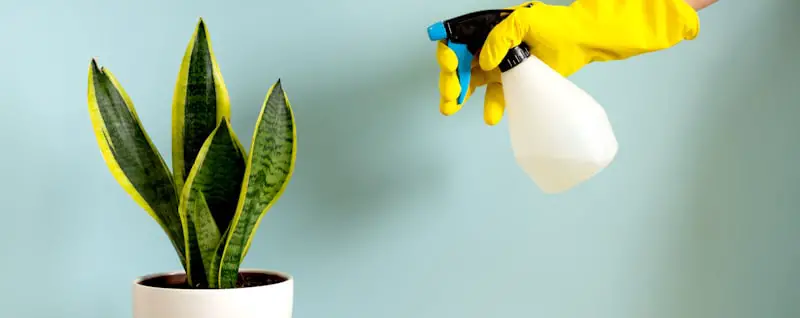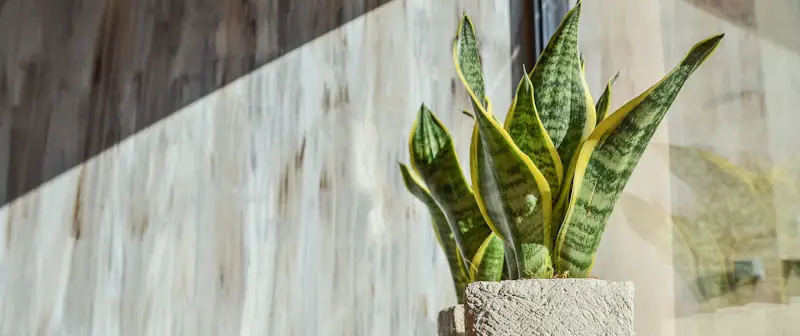The Dracaena Trifasciata, also known as the Snake Plant, is an indestructible and versatile plant perfect for gardeners. These plants are native to Africa and Asia and are easy to grow and maintain at home. Snake plants can grow in all light conditions; however, knowing their required daily light is crucial to their growth and survival.
Snake plants can thrive in any light level; however, they grow more quickly in brighter lights. Nevertheless, if placed under direct sunlight, the leaves get burned. Snake plants need at least 8 to 10 hours of indirect sunlight every day but can survive with about 5 to 6 hours of direct sunlight.
Snake plants appear in different colors, but the most common color is green featuring a yellow border. Snake plants are one of the few indestructible indoor plants, and it is considered to be a safe plant.

How Much Light Do Snake Plants Need?
Snake plants, just like every other plant, require light for survival through photosynthesis. Photosynthesis is the process in which plants manufacture their food with the help of sunlight. As much as light is needed for the growth of plants, Snake Plants can survive under any light condition.
The amount of light needed for snake plants depends greatly on the light the plant is exposed to. Snake Plants could be exposed to either direct or indirect sunlight. However, indirect sunlight is the best option to maintain Snake Plants’ green color and ensure they remain fresh and healthy.
If you do not know what indirect sunlight is, it is a form of light filtered through a blind or reflected from a window or wall, preventing sunlight’s direct reflection on your plant. The importance of indirect sunlight on Snake Plants is that it helps reduce the risk of the harsh effect of sunlight destroying them.
Snake Plants need about 8 to 10 hours of exposure to indirect sunlight for natural and healthy growth; the plants should be planted about 2 to 3 meters away from the south or east-facing windows. You can also place the plants in front of a sunny window lined with a sheer curtain.
Snake Plants could also survive under direct sunlight, however, for about 5 to 6 hours. Although direct sunlight is usually not best advised, it could make Snake Plants begin to change colors from dark green to yellow or brown while the leaves become crispy and curl downwards.
However, if you want to transition Snake Plants from indirect sunlight to direct sunlight, ensure you do so gradually. This is to observe how the plants react to the sunlight and make them get used to direct sunlight. In addition, you would need to increase the amount of water you give your plant once exposed to direct sunlight.
Snake Plant Light
Many people are unaware that you can also grow snake plants with artificial lighting; remember, this is one of the most versatile plants. We have looked at the required proportion of direct and indirect sunlight needed for the growth of snake plants. Let us look at using artificial lights to grow snake plants.
Incandescent Lights
Incandescent lights supply the required red wavelengths that stimulate the root formation of snake plants. However, incandescent lights generate more heat than other artificial lights, so you should place the light far away from the plants. For the best plant growth, use one-third incandescent light to two-thirds fluorescent light.
Fluorescent Lights
These artificial lights contain more blue wavelengths needed for the healthy growth of the plant foliage. Unlike incandescent lights, fluorescent lights do not generate lots of heat, so you can place them close to the plants. It would be best if you placed the fluorescent lights some feet away from the foliage for the best results.
Halogen Lights
Halogen lights provide a complete light spectrum; however, these lights generate lots of heat, so you should place them far away from the plants. Halogen lights are also less energy-efficient than fluorescent lights.
LED Lights
LED lights are the latest artificial lights that can aid the growth of snake plants. Light-emitting diodes or LED lights are also a low heat light source. The advantage of using LED lights is that you can customize them. LED lights produce red and blue wavelengths, aiding the growth of the root and foliage.
Snake Plant Light Requirements
Snake Plants could easily survive under different light conditions ranging from low to medium to high. However, to achieve the best growth results and healthy leaves, medium-light is the best condition to expose to a Snake Plants to thrive. Below, we will be considering each of these lights and their effects on Snake Plants.
Low Light
Unlike some other plants, Snake Plants can thrive under low light conditions for a while. If you choose to place your Snake Plant in a dark spot of the house, it will not die. However, the plant would experience a very slow growth rate. Remember, we already explained earlier that light is needed for photosynthesis in plants.
Since the plant is not getting light for photosynthesis, it might eventually die after a long while. So, to prevent a Snake Plant from dying, it is best advised that they are not left or placed in dark spots. The only downside of low light is that the plant will not be as colorful.
Medium Light
The medium-light is the best condition for growing a Snake Plant. We already mentioned earlier that about 8 to 10 hours of indirect sunlight is perfect for these plants. So, all you need to achieve medium lights is to position your Snake Plant in a south or east direction facing the window. Rest assured that your plant will thrive and stay healthy and fresh.
High Light
Truly, Snake Plants could survive under high light conditions like the sun. However, for Snake Plants used to medium lights, placing them outside or exposed directly to high light could affect their leaves and make them turn brown. So, high lights are not an excellent option for Snake Plants.
Do Snake Plants Need Sun?
Yes, Snake Plants need sun. We already explained the importance of light on photosynthesis in plants. Sun is a great source of light for plants. However, the type of light from the sun should be an indirect one. Exposing a Snake Plant to direct sunlight could lead to undesired consequences, like burning your plant leaves from deep green to brown while making their edges crispy.

Signs That A Snake Plants Is Not Getting Adequate Light
It is important that you can tell when a snake plant lacks enough light; only then can you know how to adjust the lighting. If a snake plant is not getting enough light, it has an abnormal leaf color. Healthy snake plants have thick, upright foliage with silver streaks. The foliage has impressive shades of gray, indicating chlorophyll.
When the leaves of snake plants are washed out, pale, brown, or yellow, that indicates a shortage of light. Another sign is that the leaves turn yellow and develop brown tips. You will notice that the leaves that are least exposed to light are affected first.
If you notice that the snake plants shed lots of leaves, it can be a sign of low exposure to light. Sometimes the leaf droops before falling off; you must first ensure it is not caused by diseases, overwatering, humidity, or cold drafts. Then you can adjust the lighting.
Similar post: Can Spider Plants Live Outside? Will They Survive?
Final Thoughts
Although snake plants are one of the most versatile and indestructible plants, there are some mistakes you should avoid, including placing the plant next to a cold, drafty window, exposing the plant to pests, and misting the leaves. All plants require adequate care for healthy growth.
More like this: The Best Soil for Snake Plants – How to Grow and Maintain
Victoria is the owner and main author of hobby plants. She loves spending her free time in her garden planting and taking care of her plants. Victoria hopes you enjoy the content here!

![How Often Do You Water A Snake Plant? [FIND OUT HERE] How Often Do You Water A Snake Plant? [FIND OUT HERE]](https://www.hobbyplants.com/wp-content/uploads/2022/07/how-often-do-you-water-a-snake-plant-1-300x158.jpg)
![Polka Dot Plant Care? [Everything You Need To Know] Polka Dot Plant Care? [Everything You Need To Know]](https://www.hobbyplants.com/wp-content/uploads/2022/08/polka-dot-plant-care-300x158.jpg)

![Can Snake Plants Live Outside? [COMPLETE CARE GUIDE] Can Snake Plants Live Outside? [COMPLETE CARE GUIDE]](https://www.hobbyplants.com/wp-content/uploads/2022/08/can-snake-plants-live-outside-300x158.jpg)
![Why Are My Bird of Paradise Leaves Curling? [FIND OUT HERE] Why Are My Bird of Paradise Leaves Curling? [FIND OUT HERE]](https://www.hobbyplants.com/wp-content/uploads/2022/07/bird-of-paradise-leaves-curling-300x158.jpg)
![Why Are My Orchid Leaves Turning Yellow? [Find Out Here] Why Are My Orchid Leaves Turning Yellow? [Find Out Here]](https://www.hobbyplants.com/wp-content/uploads/2022/07/orchid-leaves-turning-yellow-300x158.jpg)
![Why Is My Bamboo Plant Turning Yellow? [Find Out Here] Why Is My Bamboo Plant Turning Yellow? [Find Out Here]](https://www.hobbyplants.com/wp-content/uploads/2022/07/why-is-my-bamboo-turning-yellow-300x158.jpg)
![How To Propagate Bird Of Paradise? [Find Out Here] How To Propagate Bird Of Paradise? [Find Out Here]](https://www.hobbyplants.com/wp-content/uploads/2022/08/how-to-propagate-bird-of-paradise-300x158.jpg)
![Why Is My Aloe Plant Turning Brown? [FIND OUT HERE] Why Is My Aloe Plant Turning Brown? [FIND OUT HERE]](https://www.hobbyplants.com/wp-content/uploads/2022/07/why-is-my-aloe-plant-turning-brown-300x158.jpg)
![How Big Do Different Types Of Azaleas Get? [Find Out Here] How Big Do Different Types Of Azaleas Get? [Find Out Here]](https://www.hobbyplants.com/wp-content/uploads/2022/09/how-big-do-azaleas-get-300x158.jpg)
![What Is Bright Indirect Light For Plants? [ANSWERED] What Is Bright Indirect Light For Plants? [ANSWERED]](https://www.hobbyplants.com/wp-content/uploads/2022/08/what-is-bright-indirect-light-300x158.jpg)